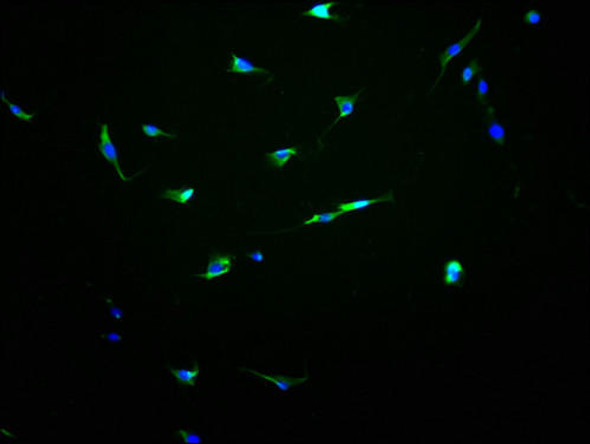Description
| Antibody Name: | JPH2 Antibody (PACO10029) |
| Antibody SKU: | PACO10029 |
| Size: | 50ul |
| Host Species: | Rabbit |
| Tested Applications: | ELISA, IHC |
| Recommended Dilutions: | |
| Species Reactivity: | Human |
| Immunogen: | Human Jph2 |
| Form: | Liquid |
| Storage Buffer: | PBS with 0.1% Sodium Azide, 50% Glycerol, pH 7.3. -20°C, Avoid freeze / thaw cycles. |
| Purification Method: | Antigen Affinity Purified |
| Clonality: | Polyclonal |
| Isotype: | IgG |
| Conjugate: | Non-conjugated |
| Synonyms: | junctophilin 2;Jph2;1110002E14Rik;JP-2;Jp2 ; |
| UniProt Protein Function: | JPH2: Junctophilins contribute to the formation of junctional membrane complexes (JMCs) which link the plasma membrane with the endoplasmic or sarcoplasmic reticulum in excitable cells. Provides a structural foundation for functional cross-talk between the cell surface and intracellular calcium release channels. JPH2 is necessary for proper intracellular Ca(2+) signaling in cardiac myocytes via its involvement in ryanodine receptor-mediated calcium ion release. Contributes to the construction of skeletal muscle triad junctions. Defects in JPH2 are the cause of familial hypertrophic cardiomyopathy type 17 (CMH17). CMH17 is a hereditary heart disorder characterized by ventricular hypertrophy, which is usually asymmetric and often involves the interventricular septum. The symptoms include dyspnea, syncope, collapse, palpitations, and chest pain. They can be readily provoked by exercise. The disorder has inter- and intrafamilial variability ranging from benign to malignant forms with high risk of cardiac failure and sudden cardiac death. Belongs to the junctophilin family. 2 isoforms of the human protein are produced by alternative splicing.Protein type: Membrane protein, integral; Contractile; Endoplasmic reticulumChromosomal Location of Human Ortholog: 20q13.12Molecular Function: calcium-release channel activity; phosphatidylinositol 3-phosphate binding; phosphatidylinositol-3,4,5-triphosphate binding; phosphatidylinositol-4,5-bisphosphate binding; phosphatidylinositol-5-phosphate binding; phosphatidylserine binding; protein bindingBiological Process: calcium ion homeostasisDisease: Cardiomyopathy, Familial Hypertrophic, 17 |
| UniProt Protein Details: | |
| NCBI Summary: | Junctional complexes between the plasma membrane and endoplasmic/sarcoplasmic reticulum are a common feature of all excitable cell types and mediate cross talk between cell surface and intracellular ion channels. The protein encoded by this gene is a component of junctional complexes and is composed of a C-terminal hydrophobic segment spanning the endoplasmic/sarcoplasmic reticulum membrane and a remaining cytoplasmic domain that shows specific affinity for the plasma membrane. This gene is a member of the junctophilin gene family. Alternative splicing has been observed at this locus and two variants encoding distinct isoforms are described. [provided by RefSeq, Jul 2008] |
| UniProt Code: | Q9BR39 |
| NCBI GenInfo Identifier: | 27805486 |
| NCBI Gene ID: | 57158 |
| NCBI Accession: | Q9BR39.2 |
| UniProt Secondary Accession: | Q9BR39,O95913, Q5JY74, Q9UJN4, E1P5X1 |
| UniProt Related Accession: | Q9BR39 |
| Molecular Weight: | 13,951 Da |
| NCBI Full Name: | Junctophilin-2 |
| NCBI Synonym Full Names: | junctophilin 2 |
| NCBI Official Symbol: | JPH2 |
| NCBI Official Synonym Symbols: | JP2; JP-2; CMH17 |
| NCBI Protein Information: | junctophilin-2 |
| UniProt Protein Name: | Junctophilin-2 |
| UniProt Synonym Protein Names: | Junctophilin type 2 |
| Protein Family: | Junctophilin |
| UniProt Gene Name: | JPH2 |
| UniProt Entry Name: | JPH2_HUMAN |






